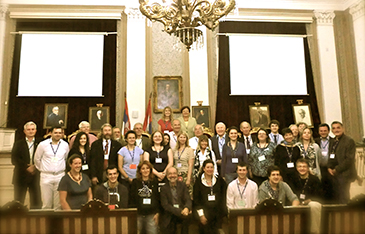An international perspective on Engagement

Written by Charlotte Thorley,
Executive Officer for Public Engagement
The beginning of October heralded the opening of the sixth European Physical Society Physics and Society Forum meeting in Belgrade, Serbia. Around 50 delegates gathered from across Europe and America to discuss improving the image of physics, to students, employers and the general public. I was invited along to share my experiences of working in this area and to showcase some approaches from the UK.
As a speaker for the theme “Improving the image with the public - engaging non-specialists”, I headed to Belgrade intending to lead a conversation around the support needed by those engaging the non-specialists, thus aiding us in building capacity in this area. I went in armed with details of the Centre for Public Engagement at QMUL, how our Centre fits into the RCUK strategy for public engagement, and how the NCCPE (National Coordinating Centre for Public Engagement) works with UK institutions to support engagement.
However, as every good engaged researcher or professional knows, you have to be prepared to change your presentation to meet the needs of your audience. This was no exception. As a public engagement Catalyst we talk at length to our own institution and our peers about the support needed to help researchers use engaged approaches to their work. The other UK institutions we talk to are at least part way down this route too, finding their own ways to build up their engagement offerings.
But the picture is not the same across the continent. Given the participants were limited to physicists and associated parties, I was expecting to primarily discuss issues of science communication and outreach rather than co-creation and partnership development. I was, however, quite taken aback by how undeveloped the activities and opinions were in even these areas. In the end the presentation was fine, and I am pleased that the final report is carrying forward some of my recommendations about future proofing the physics-engagement community by considering issues of reward and recognition now, as they develop their activities, rather than as an afterthought.
The experience made me think though. The UK is forward thinking in this regard, and we are lucky to have had the funds and support from the research councils and government for exploring public engagement activities in the way that we have. We also know that our colleagues in the States and Canada are considering these issues, if from different viewpoints. But is there more we could be doing to build an international community around public engagement with research? And how would we extend the reach of these networks out to the people actually doing the engagement?
At QMUL we’re keeping our doors open to sharing practice, and doing everything we can to be available to all the staff that work here, but I know there’s always more we can do.
By Charlotte Thorley
Executive Officer for Public Engagement
Queen Mary University of London